How to turn on warm air on the air conditioner? Guide to activating heating
Agree, the heating system in our homes is not perfect, and often we have to heat the room on our own. Not all owners of air conditioners know that the equipment can be used not only to cool the air, but also to warm it up. In this article we will tell you in detail how to turn on warm air on your air conditioner.
You will also learn the principle of operation of the air conditioner in heating mode, the rules for operating the equipment, the advantages and disadvantages of using it in winter. As a bonus, we will tell you what to do if after all the manipulations the air in the room does not heat up.
The content of the article:
- Features of the air conditioner for heating
- Which air conditioner to choose for heating?
- Installing a winter kit for air conditioning
- Permissible temperature for heating operation
- Inverter models of air conditioners
- How to set the air conditioner to heat?
- Why doesn't the air conditioner heat?
- Conclusions and useful video on the topic
Features of the air conditioner for heating
In our country, air conditioning is rarely used to heat a room. It's all about climatic features, in particular, the famous Russian frosts.
The compressor that compresses the refrigerant, which is distributed among parts of the device, “suffers” from low temperatures. Oil is dissolved in it, intended to lubricate rubbing parts. In cold weather it thickens and equipment parts wear out quickly.
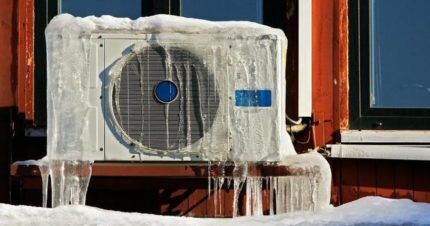
At sub-zero temperatures, the water in the drainage tube freezes and a plug forms in it, which blocks the condensate drainage. In this case, excess moisture leaks into the room through the internal casing, which leads to equipment failure.
After installing the air conditioner for heating, the refrigerant should heat up. However, due to low temperatures this does not happen. As a result, cooled refrigerant, which has not had time to heat up, enters the compressor, which leads to hydraulic gift. As a result, the device becomes unusable.
To heat the room in the off-season, you can use a simple split system. Most often this option is used during the period when The central heating hasn't been turned on yet, and the house is cool and damp. Heating with an air conditioner is more economical than most heaters (more heat is produced for the same energy consumption).
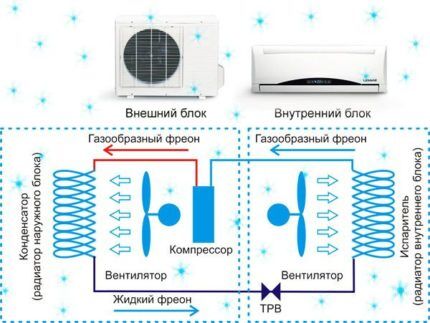
Models with a heat pump are suitable for year-round operation. The air enters the external unit, where it is warmed. Then, using freon, it is redirected to the indoor unit, from where warm air enters the room.
The main benefit of using an air conditioner to heat a room is saving energy. In heating devices, electricity is converted into heat at a ratio of 1:1.
Air conditioners do not convert electricity. It is spent on the transfer of thermal energy.To obtain 1 kilowatt of heat, 250-350 watts of energy is required, which is 3-4 times less than the consumption of a standard heater.
An air conditioner with a heating function is also indispensable in the off-season. Using an air conditioner, you can heat the air in the room to a comfortable temperature, and since there is no frost yet, nothing threatens the device.
There are few disadvantages to heating a room with an air conditioner. One device cannot heat the air in all rooms. Like other heating devices, the air conditioner dries the air.
Which air conditioner to choose for heating?
If you plan to use an air conditioner not only for cooling the air in the summer, but also for heating in the cold season, then you should choose a model with an inverter compressor. Since the equipment will be operated over a wide temperature range, a necessary condition is smooth adjustment of the compressor performance.
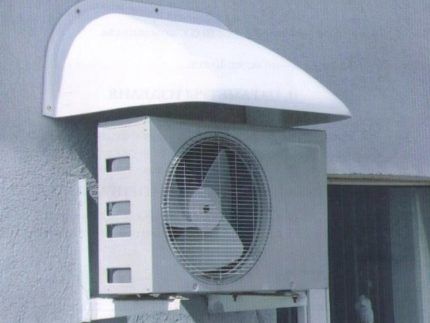
It should also be taken into account that the device must be designed to operate at temperatures of -20 - -25 C.
Only in this case can you be sure that the manufacturer has provided all the components for operation in winter:
- fan speed controller in the outdoor unit;
- presence of defrost mode;
- special compressor design;
- crankcase and compressor heating;
- heat exchanger with anti-corrosion layer, etc.
Regular models air conditioners for home or apartment They can also heat the air, but their operation is allowed at temperatures down to -5 C. However, do not forget about the opportunity to “strengthen” the equipment by installing a winter kit.
Installing a winter kit for air conditioning
Standard models of air conditioners can be retrofit winter kit, which will allow you to operate the equipment in low temperature conditions.
The package consists of several devices, which:
- heat the drainage system;
- prevent overcooling of the refrigerant;
- prevent oil from thickening.
The basic principle of operation of additional equipment:
- The temperature sensor allows you to regulate the rotation speed of the fan located in the external unit. As the temperature decreases, its speed decreases. This avoids thickening (freezing) of the oil and icing of the housing.
- Heating of the compressor crankcase, so that the device is always ready to start.
- Heating of the drainage system so that ice plugs do not form and condensate is effectively removed.
It would seem that a solution has been found. However, this was not the case. Installing a winter kit allows you to turn on the air conditioner at lower temperatures set by the manufacturer for cooling only.
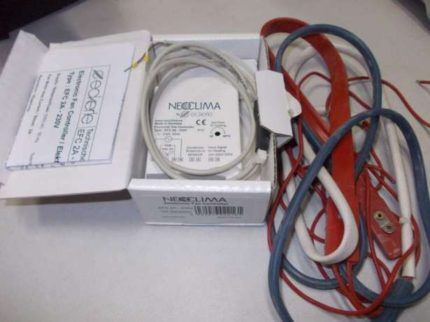
Winter kit is most often installed in rooms that are not desirable to be ventilated, but need to be cooled. For example: server and computer centers, where it is necessary to maintain an optimal temperature to preserve the equipment.
The principle of operation of an air conditioner for heating is extremely simple - heat is absorbed through evaporation, and it is released through condensation.
In order to understand how equipment heats air, you need to understand how it is cooled:
- In a gaseous state, the refrigerant enters the compressor.
- Under pressure, it is compressed and heated to a high temperature.
- The refrigerant flows from the compressor to the condenser and turns into a liquid state.
- The refrigerant pressure decreases and it is redirected to the evaporator of the indoor unit. Here it again turns into a gaseous state.
- The refrigerant “boils,” causing the air in the room to cool. The collected heat is “thrown out” onto the street.
- The refrigerant gas is returned to the compressor. The cycle is completed.
In heating mode, the condenser and evaporator change places. This becomes possible thanks to a special valve that reverses the refrigerant flow.
Permissible temperature for heating operation
Most often, most split systems operate effectively at temperatures not lower than -5°C. In severe frosts, the efficiency of the equipment drops and there is a risk of icing of the drainage system and condenser.

The lower permissible temperature limit depends on the type of refrigerant. Some air conditioners effectively heat the air even at -15°C. In harsh climatic conditions, inverter models are used, in which the intensity of the compressor can be adjusted.
Inverter models of air conditioners
Inverter air conditioners can be used all year round. Their distinctive feature lies in the way the compressor operates. As the temperature drops, performance is reduced to the required level by changing the motor speed.
Energy efficiency factor inverter air conditioner - 5. This means that you will receive 5 kW of heat by spending 1 kW of electricity.
Disadvantages of inverter air conditioning systems:
- high price;
- significant weight of the outdoor unit;
- sensitivity to voltage surges;
- more complex repairs.
Advantages:
- rapid achievement of the set temperature;
- almost silent;
- It is impossible to turn on the device at temperatures below the permissible ones.
Continuous operation of the equipment (without periodic switching on/off) allows you to save up to 30% of electricity.
How to set the air conditioner to heat?
Before turning on a conventional split system for heating, you should make sure that the equipment provides this option.
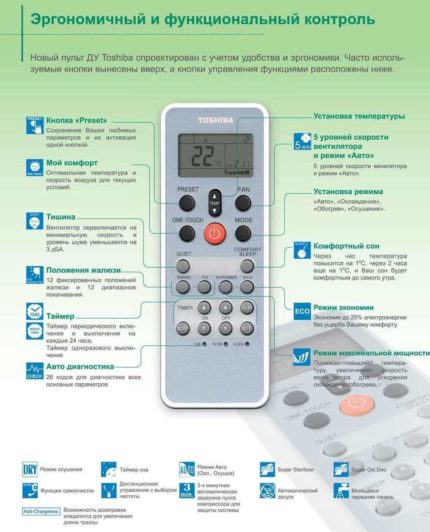
Stages of connecting the air conditioner for heating using the control panel.
- Connect the equipment to the power supply.
- Press the “on/off” button once. Most often, it differs from other buttons in color.
- Press the “Mode/Heat” key or the button with the image of a droplet, sun, or snowflake. Afterwards, an image of the sun appears on the display.
- Set the desired temperature.
Warm air will begin to flow after 5-10 minutes.
Using the control panel you can adjust the position of the blinds and the fan speed.
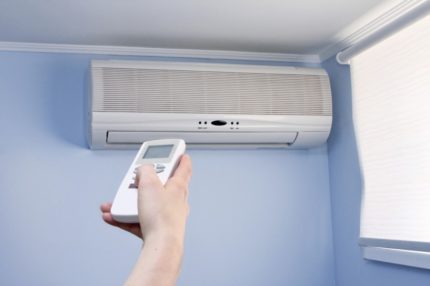
Stages of connecting the air conditioner for heating using buttons on the device itself:
- Connect the equipment to the power supply.
- Click on “on/off”. The button is located on the indoor unit or under the plastic panel. By briefly pressing the modes change (from cold to heat). A long press turns off the device.
- The temperature can only be adjusted using the control panel.
More detailed instructions on how to turn on the air conditioner for heating are in the instructions.
Why doesn't the air conditioner heat?
First of all, you should make sure whether this option is provided in the selected climate control device. If there are negative temperatures outside, the cause may be a compressor failure, freezing of the oil or drainage system.
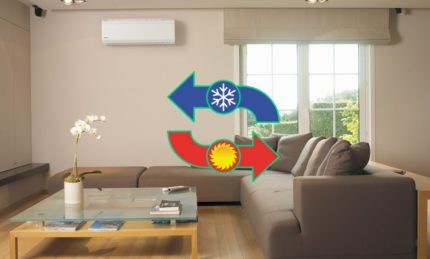
Another cause of the malfunction may be a refrigerant leak. This occurs as a result of poor soldering of interblock tubes. Call a service technician who will fix the problem and top up the refrigerant.
After air conditioner installation Filters should be cleaned on time. If you ignore this requirement, then breakdown cannot be avoided.To accurately determine the source of the problem, you need to pay attention to the display screen, which displays the error code. The meaning can be found in the instructions.
If 15 minutes after system startup The air heating has not started, try setting the settings again. To do this, read the instructions again on how to set the air conditioner for warm air. Repeat all steps from the beginning. Then turn on the system again and check its operation after 15 minutes.

The reason for the lack of heating may be an insufficient amount of freon. In this case, you should contact customer service.
Conclusions and useful video on the topic
How to turn on the air conditioner in heating mode:

Most air conditioner models will have a hard time in winter in the harsh climatic conditions of our country. The price of devices that can operate in severe frosts is steep. Using an air conditioner, it is advisable to heat a small room, as well as operate the equipment in the off-season. To fully heat a large house or an entire apartment, it is better to purchase a heater or heat gun.
What climate control equipment do you use to create favorable “weather in the house”? Or maybe you have experience setting up an air conditioner for heating? Share your stories and tips in the comments.



